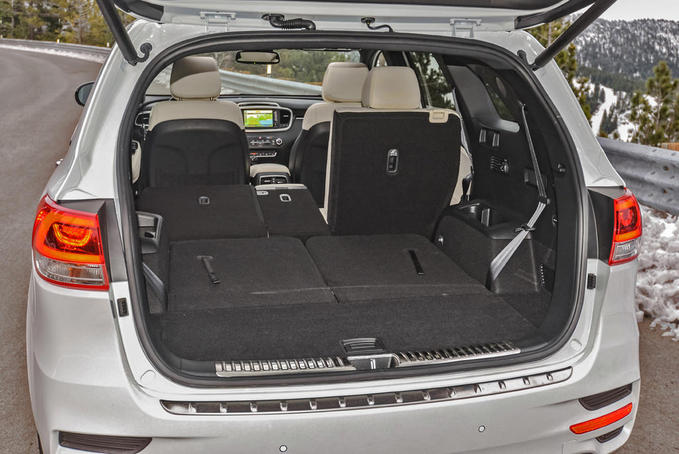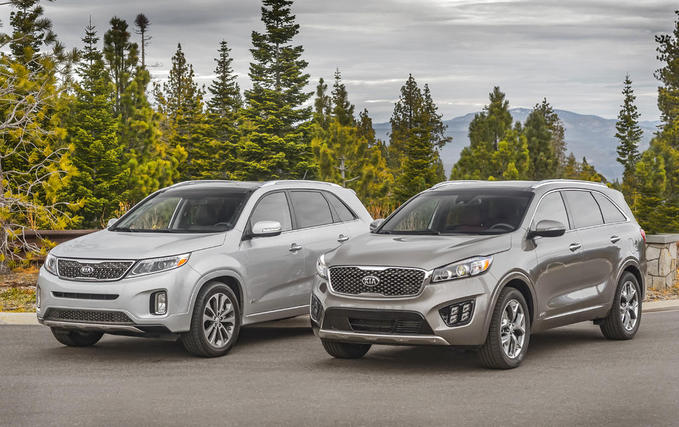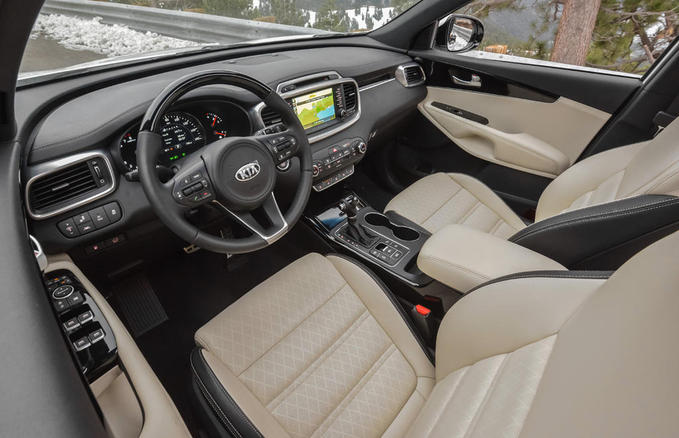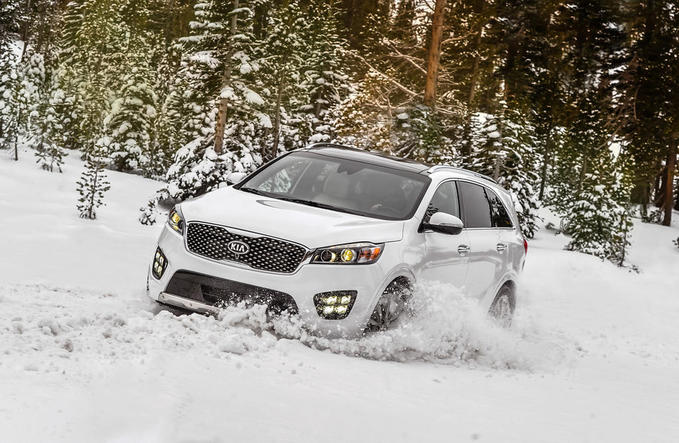For 2016, Kia has redesigned the Sorento, this despite just two years having elapsed since the last major update.
We had three primary complaints about the outgoing Sorento — access to the third row was awkward, the styling was too subtle, and we wanted to see Kia’s nifty turbocahrged four-cylinder engine under the hood — and Kia seems to have addressed all three of those concerns in the new model. Stand the old Sorento side-by-side with the new one and you’d be hard pressed to tell them apart at a glance, but a more thorough investigation shows that Kia has done their homework.
Added Interior Space
The biggest change is that the Sorento is bigger. Kia stretched both the overall length (by three inches) and the wheelbase (by 3.1 inches) in order to increase the Sorento’s interior capacity; they also dropped the Sorento’s floorpan by two inches, though the roofline is a half-inch closer to the ground and headroom compared to the old Sorento is pretty much a wash.
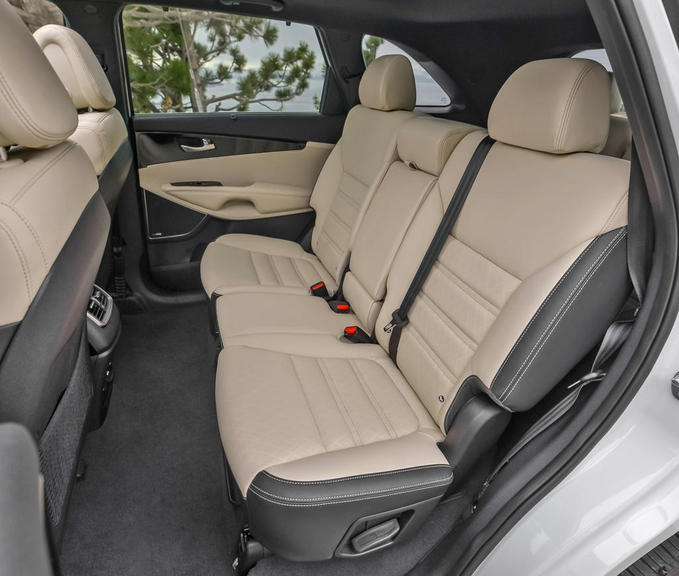
So where did that extra space go? Most of it went to the cargo area, which now offers an impressive 39 cubic feet of space behind the second row seat (up from 36.9 in last year’s Sorento). With the third row seat in place there’s now 11 cubic feet of space; that’s only two cubes more than the old car, but a bit of extra length means you can now squeeze in small suitcases stood on end rather than just a few grocery bags. And Kia has lined the cargo bay with strong scuff-resistant carpets, so you can let the kids pack the heavy suitcases.
Worthy of mention is Kia’s new “Smart Power Liftgate”. You might have heard of Ford’s version, in which the intrepid shopper, hands full of new acquisitions, can wave his or her foot under the bumper to open the tailgate. Sorento owners who opt for Kia’s version of this feature need not risk going tail-over-teakettle. Walk up behind the Sorento with the key in your pocket, wait a tick and the tailgate will open on its own. This sounds like a potential comedy of errors — we imagined scores of Kia owners giving the butt end of their Sorentos a wide berth so as to avoid inadvertently opening the trunk — but Kia’s engineers have really thought this feature out with time delays and warning beeps that minimize the farcical possibilities.
Slightly Slicker Style
Next on Kia’s hit list was the styling. Kia’s goal was to give the Sorento a more upscale look, manifested by a more expansive grille and more brightwork on the body. It looks nice enough, but so did the old Sorento. The real improvement is to be found inside. Peter Schreyer, now in his tenth year as head of design at Kia, used to work for Audi and one might guess from the Sorento’s cabin that he’s missing his old employer. The Sorento’s new dash and steering wheel look as if they were shrink-wrapped over their framework and the sparing use of bright trim has a distinct Audi-esque look (and to us, that’s a very good thing). Combined with elements we saw on the outgoing Sorento — dials and buttons that feel expensive, a big color touch-screen display with a full set of apps and a speedometer that’s actually a big round video screen (those last two only on higher trims) — and you have a cabin that ought to have several high-lux German and Japanese automakers seriously concerned.
2016 Model Year Adds Weight, new Engine
When we last tested the Sorento, we lamented the absence of the two-liter turbocharged four-cylinder engine found in the smaller Sportage. Someone at Kia must have been listening, because this 240 horsepower wonder has now joined the Sorento lineup on mid-level EX models and above. It slots in between last year’s engines, a 2.4 liter non-turbo four (which drops six HP to 185) and a 3.3-liter V6 (unchanged at 290 hp). All three engines get a six-speed automatic transmission and the driver’s choice of front- or all-wheel-drive (AWD).
We were eager to try out the new turbo four and while it was pretty quick, it wasn’t as sparkling a performer as we expected. The Sorento has gained a couple hundred pounds in its new iteration and it now weighs about two tons, give or take a couple hundred pounds depending on equipment. The new engine has its hands full shifting that much bulk and were it us signing on the dotted line, we’d opt for the V6 which, mercifully, is optional in all but the entry-level “L” model. That means giving up about 10 percent in fuel economy, at least on paper; EPA estimates are 20 MPG city/27 MPG highway for the 2.0-liter front-driver and 18/26 for the V6, while AWD figures are 19/25 for the turbo and 17/23 for the V6. In our experience, getting good fuel economy with a turbo engine depends on being able to keep your foot out of it and with the 2.0-liter Sorento, we couldn’t always keep our foot out of it. We didn’t get a chance to sample the 2.4 liter engine, but after our experience with the 2.0-liter turbo, we have no desire to try merging onto a busy interstate with 55 fewer horses under the hood.
Kia has made improvements to suspension and steering as well; lousy weather prevented us from pushing the Sorento to its limits, but we found both the ride and the adjustable-feel steering to be slightly firmer than before. We had no complaints about ride comfort and sound levels, but the extra length of the wheelbase and extra sound deadening material between the cabin and the mechanical bits have improved both.
Small Price Uptick
We can’t write a Kia review without discussing price. The five-seat, front-wheel-drive L model starts at $25,795 (including the $895 destination charge) and while we like what it offers — Bluetooth phone connectivity, stain-resistant cloth seats, alloy wheels and the look of a much more expensive car — we wouldn’t want to live with the entry-level engine. The $27,095 LX model offers more equipment and an optional ($2,100), but it’s the $31,995 EX model that really starts to feel like a luxury vehicle, with leather, dual-zone climate control and decent power by way of that 2.0-liter turbo engine.
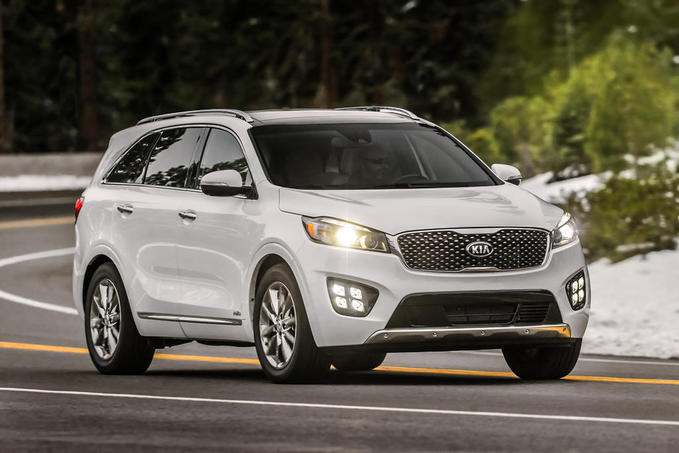
ite or silver is a mystery to us. (Does Kia think its most affluent customers are colorblind?) With all the options — V6 engine, all-wheel-drive and a Technology Package that includes a top-down parking camera, adaptive cruise control and collision- and lane-departure warning systems — it lists for $44,495. Hefty for a Kia, perhaps, but still a grand less than a Lexus RX 350 with all-wheel-drive, leather and no navigation. And if you can ignore the badge on the nose, we’d dare say that the Sorento is every bit as classy as the RX.
The Verdict
We still like the Sorento, but with the changes to the 2016 model, we find ourselves liking it for different reasons. In the past, the Sorento was a great budget-priced alternative to mainstream mid-size SUVs like the Toyota Highlander and Ford Edge; the Sorento would do all the same stuff for less money. That’s still true with the new version, but the high-end SX and Limited versions are now a credible threat to proper luxury SUVs like the Lexus RX, Audi Q5 and Acura MDX. The Kia Sorento may not quite be their equal in technology or driving experience, but nor is it anywhere near their equal in price. And so we’re pleased with the Sorento: It does everything we ask and it does it with class.







